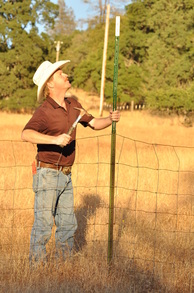Keep All The Deer Out !!!

Keep your yard and garden from being devoured?
Here are four strategies:
1. Plant what deer don't want.
If you've had trouble with deer, you already know the plants they love: cedar, yew, fruit trees, lilies, and hostas to name a few. Fortunately, there are some plants deer seem to dislike. These include most thorny plants and those with fuzzy or leathery leaves. What deer eat (and how much of it) depends greatly on the season, the particular plant, the weather and the availability of other foods. Generally speaking, the more hungry they are, the less selective they'll be.
2. Repel deer with smell and taste.
Sometimes deer need a little encouragement to stay away. Repellents discourage deer from feeding either because they have a bad taste or a noxious smell.
Rotten eggs and garlic seem to be two of the most effective deterrents around. Liquid Fence and Garlic Clips last for months, and emit smells that deer avoid.
Repellents work best when you don't have a lot of deer around and when the damage is relatively light. The longer deer have been feeding in your garden, the harder it is to get them to stop with repellents.
You'll be most successful if you put the repellents out when you first see deer damage or begin to notice deer hanging around. Make sure you follow directions and reapply as recommended. If you continue to see deer damage, switch to a different repellent, or try a frightening device.
3. Frighten deer away.
Deer always need to be on the alert for predators (coyotes, wolves, dogs, people). So sudden, unexpected noises can send a deer running for cover.
The challenge is to keep deer from becoming accustomed to the noise. If you move the devices around to different places in your garden, the deer will stay confused and unnerved.
Heavy-Duty Deer Fence
Enhance Heavy-Duty Deer Fence with reflective streamers that move in the wind.
4. Create a physical barrier.
Fencing is the most permanent and reliable deer-control solution. If you have a serious problem with deer, you'll save lots of heartache by making the investment in a sturdy fence around your yard or garden.
Deer can jump very high, so an effective fence needs be at least 7 feet tall t-post fence. If your t-post are not that tall use the t-post extenders to heighten the fence to protect your garden during the growing season.
Deer may try to go over, under or through a fence, so make sure it is securely staked to wood or metal posts and that it goes all the way to the ground. For added security and height add the T-post Extender to the top of your t-post fence.
I know that many gardeners also have success wrapping susceptible shrubs with black nylon netting or nylon window screening. This is a very useful technique to help reduce winter browsing.The Easy-Up Lightweight Fence works well for this job. but you need it tall.
Here are four strategies:
1. Plant what deer don't want.
If you've had trouble with deer, you already know the plants they love: cedar, yew, fruit trees, lilies, and hostas to name a few. Fortunately, there are some plants deer seem to dislike. These include most thorny plants and those with fuzzy or leathery leaves. What deer eat (and how much of it) depends greatly on the season, the particular plant, the weather and the availability of other foods. Generally speaking, the more hungry they are, the less selective they'll be.
2. Repel deer with smell and taste.
Sometimes deer need a little encouragement to stay away. Repellents discourage deer from feeding either because they have a bad taste or a noxious smell.
Rotten eggs and garlic seem to be two of the most effective deterrents around. Liquid Fence and Garlic Clips last for months, and emit smells that deer avoid.
Repellents work best when you don't have a lot of deer around and when the damage is relatively light. The longer deer have been feeding in your garden, the harder it is to get them to stop with repellents.
You'll be most successful if you put the repellents out when you first see deer damage or begin to notice deer hanging around. Make sure you follow directions and reapply as recommended. If you continue to see deer damage, switch to a different repellent, or try a frightening device.
3. Frighten deer away.
Deer always need to be on the alert for predators (coyotes, wolves, dogs, people). So sudden, unexpected noises can send a deer running for cover.
The challenge is to keep deer from becoming accustomed to the noise. If you move the devices around to different places in your garden, the deer will stay confused and unnerved.
Heavy-Duty Deer Fence
Enhance Heavy-Duty Deer Fence with reflective streamers that move in the wind.
4. Create a physical barrier.
Fencing is the most permanent and reliable deer-control solution. If you have a serious problem with deer, you'll save lots of heartache by making the investment in a sturdy fence around your yard or garden.
Deer can jump very high, so an effective fence needs be at least 7 feet tall t-post fence. If your t-post are not that tall use the t-post extenders to heighten the fence to protect your garden during the growing season.
Deer may try to go over, under or through a fence, so make sure it is securely staked to wood or metal posts and that it goes all the way to the ground. For added security and height add the T-post Extender to the top of your t-post fence.
I know that many gardeners also have success wrapping susceptible shrubs with black nylon netting or nylon window screening. This is a very useful technique to help reduce winter browsing.The Easy-Up Lightweight Fence works well for this job. but you need it tall.

